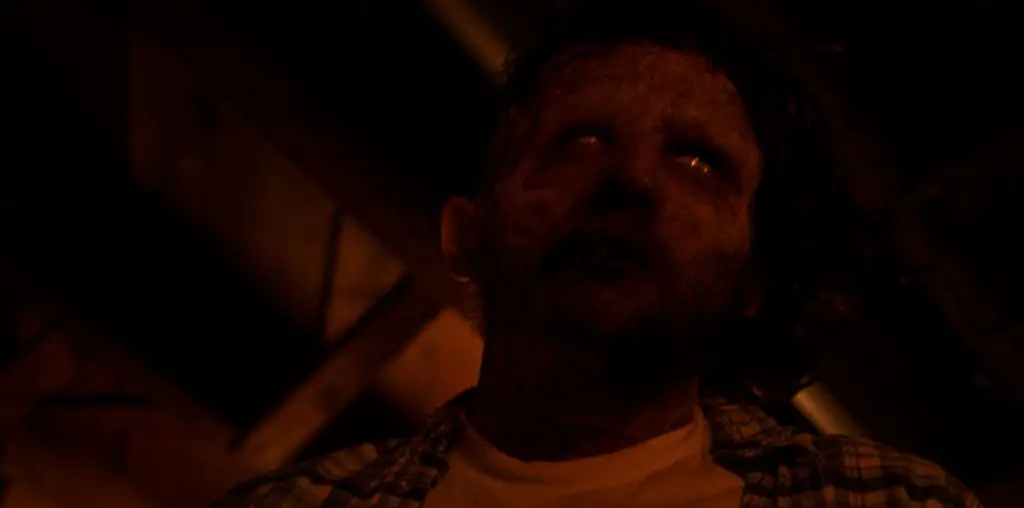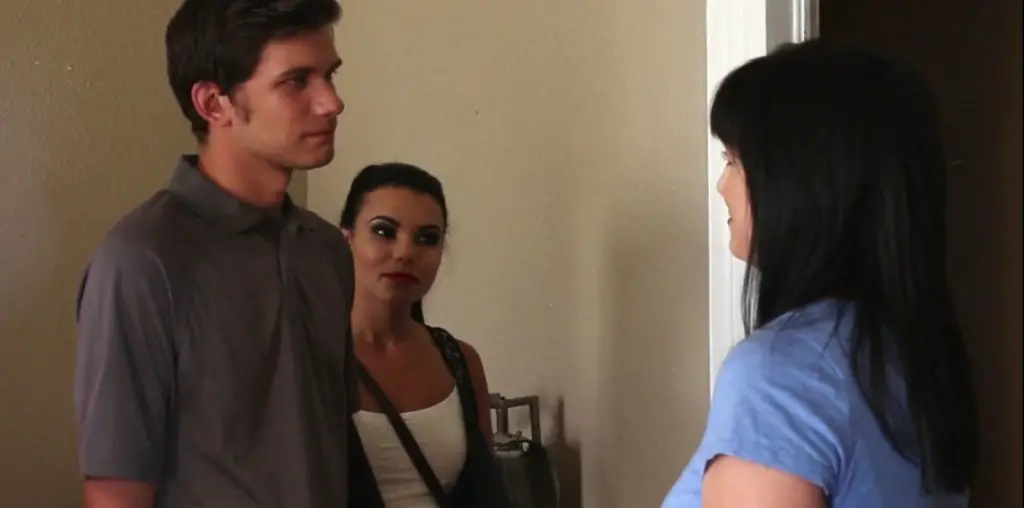
BOOTLEG FILES 534: “Parable” (1964 experimental Christian film).
LAST SEEN: The film is on YouTube.
AMERICAN HOME VIDEO: Actually, it was on DVD for a few years.
REASON FOR BOOTLEG STATUS: An out-of-print title with a curious history.
CHANCES OF SEEING A COMMERCIAL DVD RELEASE: It would be wonderful if there was a proper restoration of this title.
Fifty years ago, the most controversial movie playing in New York was not on the screen at some fleapit venue specializing in underground flicks, nor was it in the ritzy first-run houses that framed Times Square. Instead, it was playing at the Protestant and Orthodox Center at the 1964/65 World’s Fair. The film in question was called “Parable,” and the brouhaha surrounding its contents was nothing short of astonishing.
The Protestant and Orthodox Center was a World’s Fair pavilion sponsored by the Protestant Council of New York City. More than 20 denominations were represented at this venue, which included a chapel, a children’s center, and the “Court of Christian Pioneers” that honored the ministries of 34 notable theologians. And while it may seem a bit odd to some contemporary readers that a religious pavilion would be part of a World’s Fair, it should be noted that there were several faith-based venues at that event, including venues sponsored by the Mormons, the Christian Science faith and Billy Graham’s ministry; the Vatican had a very popular pavilion that housed Michelangelo’s “Pieta.”
As with many World’s Fair pavilions, the Protestant and Orthodox Center included a cinema that offered a special film created for the fair. But anyone that came to the center expecting a stodgy sermon-type offering was in for a shock. The film being screened was called “Parable,” and it took the message of Christ’s teachings into a bold and surreal new realm.
“Parable” takes place in a traveling circus, and the film opens with the procession of animals and acrobats on their way to a new town. Trailing slightly behind the procession is a clown with a chalk-white head and face and an oversized white costume. The clown is riding a donkey, and whether he is part of the circus or just trailing along is not immediately clear.
The clown makes his way through the circus, gently interrupting the lives of several people. He takes the buckets of water that an animal trainer has filled with lake water and brings it to a pair of elephants, and they parched pachyderms happily drink to quench their thirst. He then spies a dunk tank game, where a white man in a suit is trying (and repeatedly) failing to submerge the black man sitting at the edge of the tank. The clown trades places with the black man – and when the white man throws a ball directly at the black man, it is caught and then tossed back to the would-be pitcher. (A stray pitch winds up dunking the clown in the tank, but he emerges without smeared make-up.)
The clown, followed by the animal trainer and dunk tank man, then breezes past a barker trying to sell tickets to a side show. The clown views an unhappy woman that is part of a magic act – he trades places with her, allowing her to escape from her position. (The speed of her exit suggests that her unhappiness is more than a mere case of being occupationally dissatisfied.)
The clown then enters the main circus tent, where Magnus the Great is performing his Living Marionettes act. This consists of three people strung up on harnesses above the audience, with Magnus sitting on a large throne while manipulating the cables that hold up his “living marionettes.” The clown distracts the all-child audience by cleaning their feet with a whisk broom – and within seconds, all of the kids are cleaning each others’ shoes. The clown pulls down the living marionettes, and they promptly slip out of their harnesses and run off – with the audience following them.
The clown then voluntarily puts himself into an empty harness, and Magnus hoists him into the air. The three men that had their day disrupted – the man throwing balls at the dunk tank, the barker and the man whose lady ran away from their magic act – come in and start to beat the clown. The magic act character takes a sword and stabs the clown, who is then hoisted higher. The clown cries in anguish and dies, suspended in midair.
Eventually, the circus folds up and rolls off to another town. But Magnus, who is guilt-ridden over what transpires, smears white make-up over his face and assumes the dead clown’s costume – and he is last seen riding on the clown’s donkey after the circus procession.
Directed by Rolf Forsberg and Tom Rook, based on Forsberg’s dialogue-free screenplay, “Parable” offered a strange twist on the very familiar story of the Gospels. Several stories from Christ’s life received an odd updating – for example, cleaning feet with whisk brooms instead of washing the feet – and there was also a very contemporary (if not very subtle) plea for racial equality in the ball toss at the dunk tank. But the idea of a Christ-like figure in clown’s make-up and costume was a wild artistic leap, and one that nearly killed “Parable” before it was screened.
Somehow or other, word got out to Robert Moses, the president of the World’s Fair, who imagined the worst (perhaps he thought the film would take an Emmett Kelly approach to clowning and have Jesus sweeping a spotlight with a broom). Moses put heavy pressure on the Protestant and Orthodox Center to withdraw the film. An executive with Con Edison, the local electrical utility, threatened to shut off power to that pavilion, and a local minister promised to take a gun to the pavilion and blast holes in the screen. But these protests only served to call attention to the film, and “Parable” quickly became a must-see attraction. To the shock of the film’s detractors, it received rapturous praise from critics (Newsweek said it was “very probably the best film at the fair”) and fair attendees filled the pavilion’s 370-seat cinema to experience the film.
After the World’s Fair closed, “Parable” found its way into several major film festivals and into many churches and libraries. Although some controversy continued to shadow it – an attempt was made to have it purged from the Los Angeles public library’s film collection in 1975 – “Parable” had a long life in non-theatrical release. However, co-director Forsberg would later complain that the non-theatrical settings were inappropriate to his visit – “Parable” was originally projected in a widescreen format, and Forsberg felt the production was poorly served in 16mm presentations.
For a number of years, “Parable” was out of circulation due to problems relating to ownership rights. That was resolved in 2004 when EcuFilm, the ecumenical media distribution service of United Methodist Communications, released “Parable” on VHS and DVD. EcuFilm shut down in late 2013 and, as of this writing, “Parable” is no longer being sold for home entertainment release. (Or at least it is not listed on the United Methodist Communications website – I am unable to locate evidence that the title is still in commercial release.)
“Parable” had brief moment of late attention in 2012 when it was added to the Library of Congress’ National Film Registry, and later in 2013 during a Los Angeles retrospective of Forsberg’s career. However, the film has been unfairly forgotten and is rarely shown in public. An unauthorized posting from a less-than-pristine video is on YouTube, albeit under the Spanish title “Parabola,” and this enables contemporary viewers to appreciate an unusual landmark in the Christian film genre.
IMPORTANT NOTICE: The unauthorized duplication and distribution of copyright-protected material, either for crass commercial purposes or profit-free s***s and giggles, is not something that the entertainment industry appreciates. On occasion, law enforcement personnel boost their arrest quotas by collaring cheery cinephiles engaged in such activities. So if you are going to copy and distribute bootleg material, a word to the wise: don’t get caught. Oddly, the purchase and ownership of bootleg DVDs is perfectly legal. Go figure!

